New Composite Contrast Agents Based on Ln and Graphene Matrix for Multi-Energy Computed Tomography
Abstract
1. Introduction
2. Materials and Methods
2.1. Synthesis
2.2. Physio-Chemical Analysis
2.3. Multi-Energy Computed Tomography
3. Results and Discussion
3.1. GNFs, GNFs_ox, and GNFs_ox_400 Characterizations
3.2. Ln/GNFs_ox Characterizations
3.3. Multi-Energy Computed Tomography: A Phantom Study
- The creation of the X-ray projection of the study object at a certain angle for each energy threshold;
- Rotation of the study object to the next angle;
- Repetition of steps 1 and 2 until the object rotates 360 degrees;
- The creation of the flat field images for each energy threshold;
- The creation of the dark field images (to identify non-working and noisy detector pixels);
- Flat field correction for each energy threshold;
- 3D reconstruction for each energy threshold;
- Analysis of the absorption coefficients for each voxel at each energy threshold;
- The calculation of the voxel K-line;
- The comparison of the voxel K-line with the absorption K-lines of known elements.
4. Conclusions
Supplementary Materials
Author Contributions
Funding
Data Availability Statement
Acknowledgments
Conflicts of Interest
References
- Lusic, H.; Grinstaff, M.W. X-Ray-Computed Tomography Contrast Agents. Chem. Rev. 2013, 113, 1641–1666. [Google Scholar] [CrossRef] [PubMed]
- Wallyn, J.; Anton, N.; Akram, S.; Vandamme, T.F. Biomedical Imaging: Principles, Technologies, Clinical Aspects, Contrast Agents, Limitations and Future Trends in Nanomedicines. Pharm. Res. 2019, 36, 78. [Google Scholar] [CrossRef] [PubMed]
- Hsu, J.C.; Nieves, L.M.; Betzer, O.; Sadan, T.; Noël, P.B.; Popovtzer, R.; Cormode, D.P. Nanoparticle Contrast Agents for X-ray Imaging Applications. WIREs Nanomed. Nanobiotechnol. 2020, 12, e1642. [Google Scholar] [CrossRef]
- Ostadhossein, F.; Tripathi, I.; Benig, L.; LoBato, D.; Moghiseh, M.; Lowe, C.; Raja, A.; Butler, A.; Panta, R.; Anjomrouz, M.; et al. Multi-“Color” Delineation of Bone Microdamages Using Ligand-Directed Sub-5 Nm Hafnia Nanodots and Photon Counting CT Imaging. Adv. Funct. Mater. 2020, 30, 1904936. [Google Scholar] [CrossRef]
- Anderson, N.G.; Butler, A.P.; Scott, N.J.A.; Cook, N.J.; Butzer, J.S.; Schleich, N.; Firsching, M.; Grasset, R.; de Ruiter, N.; Campbell, M.; et al. Spectroscopic (Multi-Energy) CT Distinguishes Iodine and Barium Contrast Material in MICE. Eur. Radiol. 2010, 20, 2126–2134. [Google Scholar] [CrossRef]
- Symons, R.; Cork, T.E.; Lakshmanan, M.N.; Evers, R.; Davies-Venn, C.; Rice, K.A.; Thomas, M.L.; Liu, C.-Y.; Kappler, S.; Ulzheimer, S.; et al. Dual-Contrast Agent Multi energy Computed Tomography of the Heart: Initial Experience. Int. J. Cardiovasc. Imaging 2017, 33, 1253–1261. [Google Scholar] [CrossRef]
- Symons, R.; Krauss, B.; Sahbaee, P.; Cork, T.E.; Lakshmanan, M.N.; Bluemke, D.A.; Pourmorteza, A. Multi energy CT for Simultaneous Imaging of Multiple Contrast Agents in the Abdomen: An in Vivo Study. Med. Phys. 2017, 44, 5120–5127. [Google Scholar] [CrossRef] [PubMed]
- Kim, J.; Bar-Ness, D.; Si-Mohamed, S.; Coulon, P.; Blevis, I.; Douek, P.; Cormode, D.P. Assessment of Candidate Elements for Development of Spectral Multi energy CT Specific Contrast Agents. Sci. Rep. 2018, 8, 12119. [Google Scholar] [CrossRef]
- Nowak, T.; Hupfer, M.; Brauweiler, R.; Eisa, F.; Kalender, W.A. Potential of High-Z Contrast Agents in Clinical Contrast-Enhanced Computed Tomography. Med. Phys. 2011, 38, 6469–6482. [Google Scholar] [CrossRef]
- Roessler, A.-C.; Hupfer, M.; Kolditz, D.; Jost, G.; Pietsch, H.; Kalender, W.A. High Atomic Number Contrast Media Offer Potential for Radiation Dose Reduction in Contrast-Enhanced Computed Tomography. Invest. Radiol. 2016, 51, 249–254. [Google Scholar] [CrossRef]
- Amato, C.; Klein, L.; Wehrse, E.; Rotkopf, L.T.; Sawall, S.; Maier, J.; Ziener, C.H.; Schlemmer, H.; Kachelrieß, M. Potential of Contrast Agents Based on High-Z Elements for Contrast-enhanced Photon-counting Computed Tomography. Med. Phys. 2020, 47, 6179–6190. [Google Scholar] [CrossRef]
- Si-Mohamed, S.; Cormode, D.P.; Bar-Ness, D.; Sigovan, M.; Naha, P.C.; Langlois, J.-B.; Chalabreysse, L.; Coulon, P.; Blevis, I.; Roessl, E.; et al. Evaluation of Spectral Photon Counting Computed Tomography K-Edge Imaging for Determination of Gold Nanoparticle Biodistribution in Vivo. Nanoscale 2017, 9, 18246–18257. [Google Scholar] [CrossRef]
- Dunning, C.A.S.; O’Connell, J.; Robinson, S.M.; Murphy, K.J.; Frencken, A.L.; van Veggel, F.C.J.M.; Iniewski, K.; Bazalova-Carter, M. Multi energy Computed Tomography of Lanthanide Contrast Agents with a High-Flux 330-Μm-Pitch Cadmium Zinc Telluride Detector in a Table-Top System. J. Med. Imaging 2020, 7, 1. [Google Scholar] [CrossRef] [PubMed]
- Smith, K.; Getzin, M.; Garfield, J.J.; Suvarnapathaki, S.; Camci-Unal, G.; Wang, G.; Gkikas, M. Nanophosphor-Based Contrast Agents for Spectral X-Ray Imaging. Nanomaterials 2019, 9, 1092. [Google Scholar] [CrossRef] [PubMed]
- Richtsmeier, D.; Dunning, C.A.S.; Iniewski, K.; Bazalova-Carter, M. Multi-Contrast K-Edge Imaging on a Bench-Top Multi energy CT System: Acquisition Parameter Study. J. Instrum. 2020, 15, P10029. [Google Scholar] [CrossRef]
- Carrascosa, P.; Capunay, C.; Deviggiano, A.; Bettinotti, M.; Goldsmit, A.; Tajer, C.; Carrascosa, J.; Garcia, M.J. Feasibility of 64-Slice Gadolinium-Enhanced Cardiac CT for the Evaluation of Obstructive Coronary Artery Disease. Heart 2010, 96, 1543–1549. [Google Scholar] [CrossRef] [PubMed]
- Levine, D.; McDonald, R.J.; Kressel, H.Y. Gadolinium Retention After Contrast-Enhanced MRI. JAMA 2018, 320, 1853. [Google Scholar] [CrossRef]
- McDonald, R.J.; McDonald, J.S.; Kallmes, D.F.; Jentoft, M.E.; Murray, D.L.; Thielen, K.R.; Williamson, E.E.; Eckel, L.J. Intracranial Gadolinium Deposition after Contrast-Enhanced MR Imaging. Radiology 2015, 275, 772–782. [Google Scholar] [CrossRef]
- Cormode, D.P.; Naha, P.C.; Fayad, Z.A. Nanoparticle Contrast Agents for Computed Tomography: A Focus on Micelles. Contrast Media Mol. Imaging 2014, 9, 37–52. [Google Scholar] [CrossRef]
- De La Vega, J.C.; Häfeli, U.O. Utilization of Nanoparticles as X-Ray Contrast Agents for Diagnostic Imaging Applications. Contrast Media Mol. Imaging 2015, 10, 81–95. [Google Scholar] [CrossRef]
- Cormode, D.P.; Roessl, E.; Thran, A.; Skajaa, T.; Gordon, R.E.; Schlomka, J.-P.; Fuster, V.; Fisher, E.A.; Mulder, W.J.M.; Proksa, R.; et al. Atherosclerotic Plaque Composition: Analysis with Multicolor CT and Targeted Gold Nanoparticles. Radiology 2010, 256, 774–782. [Google Scholar] [CrossRef] [PubMed]
- Roeder, R.K.; Curtis, T.E.; Nallathamby, P.D.; Irimata, L.E.; McGinnity, T.L.; Cole, L.E.; Vargo-Gogola, T.; Cowden Dahl, K.D. Nanoparticle Imaging Probes for Molecular Imaging with Computed Tomography and Application to Cancer Imaging. In Proceedings of the Medical Imaging 2017: Physics of Medical Imaging; Flohr, T.G., Lo, J.Y., Gilat Schmidt, T., Eds.; SPIE Medical Imaging: Orlando, FL, USA, 2017; p. 101320X. [Google Scholar]
- Pershina, A.G.; Sazonov, A.E.; Milto, I.V. Application of Magnetic Nanoparticles in Biomedicine. Bull. Sib. Med. 2008, 7, 70–78. [Google Scholar] [CrossRef]
- Huo, S.; Chen, S.; Gong, N.; Liu, J.; Li, X.; Zhao, Y.; Liang, X.-J. Ultrasmall Gold Nanoparticles Behavior in Vivo Modulated by Surface Polyethylene Glycol (PEG) Grafting. Bioconjug. Chem. 2017, 28, 239–243. [Google Scholar] [CrossRef] [PubMed]
- Kumar, P.; Tambe, P.; Paknikar, K.M.; Gajbhiye, V. Mesoporous Silica Nanoparticles as Cutting-Edge Theranostics: Advancement from Merely a Carrier to Tailor-Made Smart Delivery Platform. J. Control. Release 2018, 287, 35–57. [Google Scholar] [CrossRef] [PubMed]
- Vivero-Escoto, J.L.; Huxford-Phillips, R.C.; Lin, W. Silica-Based Nanoprobes for Biomedical Imaging and Theranostic Applications. Chem. Soc. Rev. 2012, 41, 2673. [Google Scholar] [CrossRef]
- Chen, N.-T.; Cheng, S.-H.; Souris, J.S.; Chen, C.-T.; Mou, C.-Y.; Lo, L.-W. Theranostic Applications of Mesoporous Silica Nanoparticles and Their Organic/Inorganic Hybrids. J. Mater. Chem. B 2013, 1, 3128. [Google Scholar] [CrossRef]
- McDevitt, M.R.; Chattopadhyay, D.; Kappel, B.J.; Jaggi, J.S.; Schiffman, S.R.; Antczak, C.; Njardarson, J.T.; Brentjens, R.; Scheinberg, D.A. Tumor Targeting with Antibody-Functionalized, Radiolabeled Carbon Nanotubes. J. Nucl. Med. 2007, 48, 1180–1189. [Google Scholar] [CrossRef] [PubMed]
- Savilov, S.V.; Strokova, N.E.; Ivanov, A.S.; Arkhipova, E.A.; Desyatov, A.V.; Hui, X.; Aldoshin, S.M.; Lunin, V.V. Nanoscale Carbon Materials from Hydrocarbons Pyrolysis: Structure, Chemical Behavior, Utilisation for Non-Aqueous Supercapacitors. Mater. Res. Bull. 2015, 69, 13–19. [Google Scholar] [CrossRef]
- Chernyak, S.A.; Ivanov, A.S.; Podgornova, A.M.; Arkhipova, E.A.; Kupreenko, S.Y.; Shumyantsev, A.V.; Strokova, N.E.; Maslakov, K.I.; Savilov, S.V.; Lunin, V.V. Kinetics of the Defunctionalization of Oxidized Few-Layer Graphene Nanoflakes. Phys. Chem. Chem. Phys. 2018, 20, 24117–24122. [Google Scholar] [CrossRef] [PubMed]
- Motorized Rotation Stage—Motorized Positioners & Controllers—Catalog—Opto-Mechanical Products—Standa. Available online: https://web.archive.org/web/20221001134042/https://www.standa.lt/products/catalog/motorised_positioners?item=244 (accessed on 1 October 2022).
- OEM—Source-Ray. Available online: https://web.archive.org/web/20221001134920/https://sourceray.com/products/oem-source-blocks/ (accessed on 1 October 2022).
- Gimenez, E.N.; Ballabriga, R.; Blaj, G.; Campbell, M.; Dolbnya, I.; Frodjh, E.; Horswell, I.; Llopart, X.; Marchal, J.; McGrath, J.; et al. Medipix3RX: Characterizing the Medipix3 Redesign with Synchrotron Radiation. IEEE Trans. Nucl. Sci. 2015, 62, 1413–1421. [Google Scholar] [CrossRef]
- Park, S.E.; Kim, J.G.; Hegazy, M.A.A.; Cho, M.H.; Lee, S.Y. A Flat-Field Correction Method for Multi energy-Detector-Based Micro-CT. In Proceedings of the Medical Imaging 2014: Physics of Medical Imaging; Whiting, B.R., Hoeschen, C., Eds.; SPIE Medical Imaging: San-Diego, CA, USA, 2014; p. 90335N. [Google Scholar]
- Van Aarle, W.; Palenstijn, W.J.; Cant, J.; Janssens, E.; Bleichrodt, F.; Dabravolski, A.; De Beenhouwer, J.; Joost Batenburg, K.; Sijbers, J. Fast and Flexible X-Ray Tomography Using the ASTRA Toolbox. Opt. Express 2016, 24, 25129. [Google Scholar] [CrossRef]
- Nemanich, R.J.; Solin, S.A. First- and Second-Order Raman Scattering from Finite-Size Crystals of Graphite. Phys. Rev. B 1979, 20, 392–401. [Google Scholar] [CrossRef]
- Obraztsova, E.D.; Fujii, M.; Hayashi, S.; Kuznetsov, V.L.; Butenko, Y.V.; Chuvilin, A.L. Raman Identification of Onion-like Carbon. Carbon N. Y. 1998, 36, 821–826. [Google Scholar] [CrossRef]
- Ma, B.; Rodriguez, R.D.; Ruban, A.; Pavlov, S.; Sheremet, E. The Correlation between Electrical Conductivity and Second-Order Raman Modes of Laser-Reduced Graphene Oxide. Phys. Chem. Chem. Phys. 2019, 21, 10125–10134. [Google Scholar] [CrossRef]
- Beamson, G.; Briggs, D. High Resolution XPS of Organic Polymers: The Scienta ESCA300 Database. J. Chem. Educ. 1993, 70, A25. [Google Scholar]
- Chernyak, S.A.; Ivanov, A.S.; Strokova, N.E.; Maslakov, K.I.; Savilov, S.V.; Lunin, V.V. Mechanism of Thermal Defunctionalization of Oxidized Carbon Nanotubes. J. Phys. Chem. C 2016, 120, 17465–17474. [Google Scholar] [CrossRef]
- Gobichon, A. Thermal Decomposition of Neutral and Basic Lanthanum Nitrates Studied with Temperature-Dependent Powder Diffraction and Thermogravimetric Analysis. Solid State Ion. 1996, 93, 51–64. [Google Scholar] [CrossRef]
- Mentus, S.; Jelić, D.; Grudić, V. Lanthanum Nitrate Decomposition by Both Temperature Programmed Heating and Citrate Gel Combustion. J. Therm. Anal. Calorim. 2007, 90, 393–397. [Google Scholar] [CrossRef]
- Biamino, S.; Badini, C. Combustion Synthesis of Lanthanum Chromite Starting from Water Solutions: Investigation of Process Mechanism by DTA–TGA–MS. J. Eur. Ceram. Soc. 2004, 24, 3021–3034. [Google Scholar] [CrossRef]
- Chernyak, S.A.; Stolbov, D.N.; Ivanov, A.S.; Klokov, S.V.; Egorova, T.B.; Maslakov, K.I.; Eliseev, O.L.; Maximov, V.V.; Savilov, S.V.; Lunin, V.V. Effect of Type and Localization of Nitrogen in Graphene Nanoflake Support on Structure and Catalytic Performance of Co-Based Fischer-Tropsch Catalysts. Catal. Today 2020, 357, 193–202. [Google Scholar] [CrossRef]
- Amaya, Á.A.; González, C.A.; Niño-Gómez, M.E.; Martínez, O.F. XPS Fitting Model Proposed to the Study of Ni and La in Deactivated FCC Catalysts. J. Electron Spectros. Relat. Phenomena 2019, 233, 5–10. [Google Scholar] [CrossRef]
- Mullica, D.F.; Perkins, H.O.; Lok, C.K.C.; Young, V. The X-Ray Photoemission Spectra of La(OH)3. J. Electron Spectros. Relat. Phenom. 1993, 61, 337–355. [Google Scholar] [CrossRef]
- Baltrus, J.P.; Keller, M.J. Rare Earth Oxides Eu2O3 and Nd2O3 Analyzed by XPS. Surf. Sci. Spectra 2019, 26, 014001. [Google Scholar] [CrossRef]
- Teterin, Y.A.; Teterin, A.Y. Structure of X-Ray Photoelectron Spectra of Lanthanide Compounds. Russ. Chem. Rev. 2002, 71, 347–381. [Google Scholar] [CrossRef]
- Raiser, D.; Deville, J.P. Study of XPS Photoemission of Some Gadolinium Compounds. J. Electron Spectros. Relat. Phenom. 1991, 57, 91–97. [Google Scholar] [CrossRef]
- Li, J.P.H.; Zhou, X.; Pang, Y.; Zhu, L.; Vovk, E.I.; Cong, L.; van Bavel, A.P.; Li, S.; Yang, Y. Understanding of binding energy calibration in XPS of lanthanum oxide by in situ treatment. Phys. Chem. Chem. Phys. 2019, 21, 22351–22358. [Google Scholar] [CrossRef]
- Suslova, E.; Shashurin, D.; Kozlov, A.; Maximov, S.; Rozhkov, V.; Sotenskii, R.; Savilov, S.; Medvedev, O.; Chelkov, G. Development of La-graphene composite contrasting agents for photon-counting computed tomography. Func. Mat. Lett. 2022; in press. [Google Scholar]
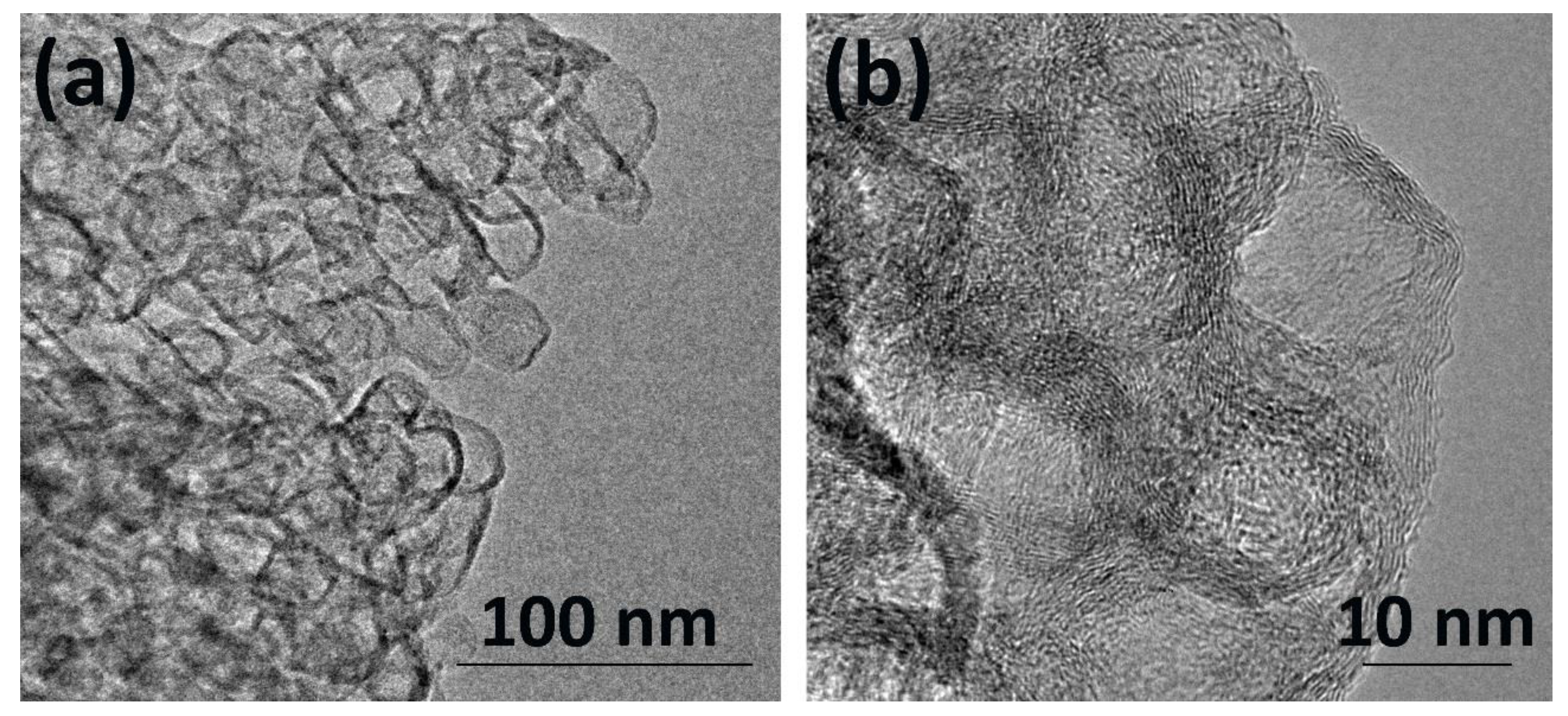
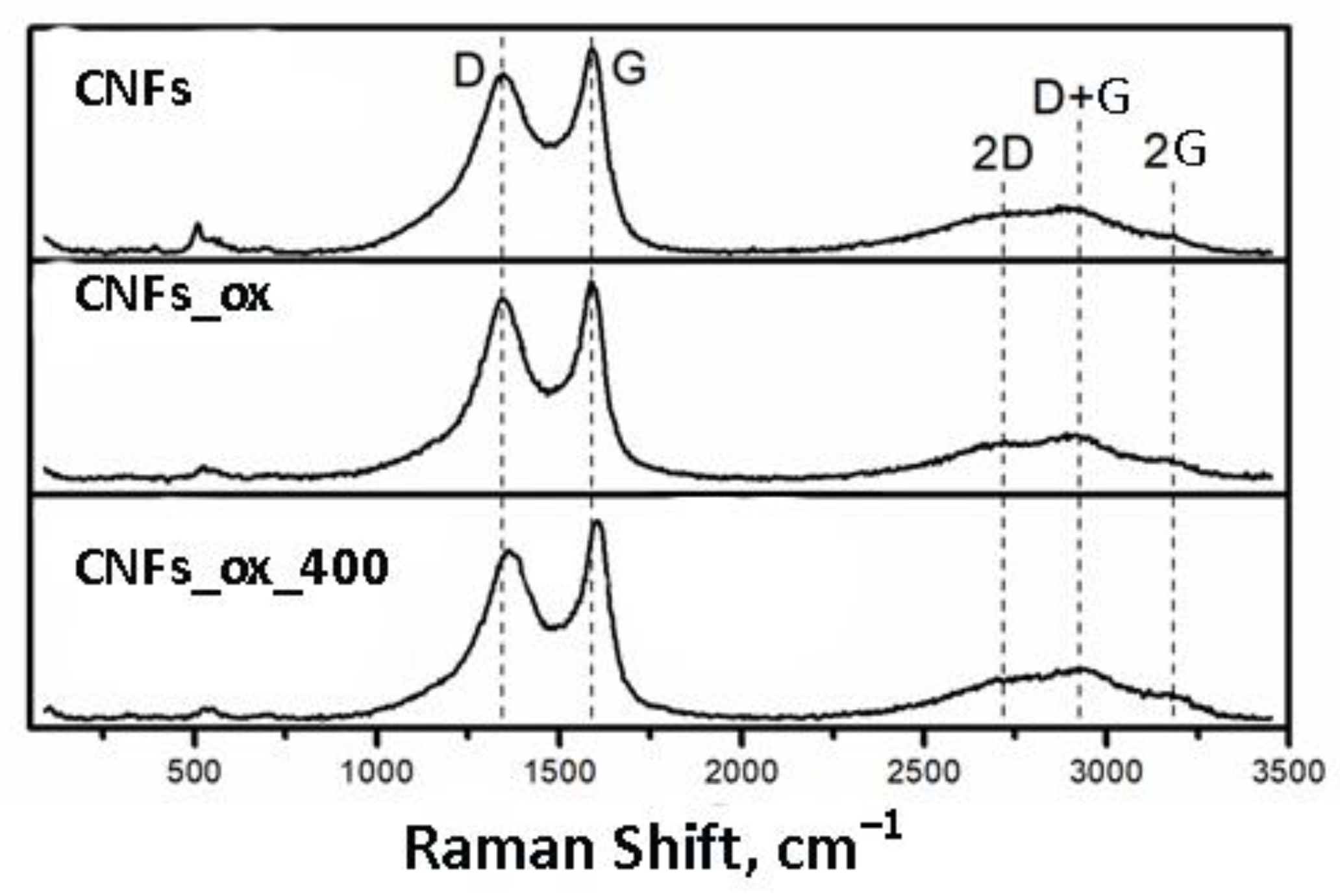
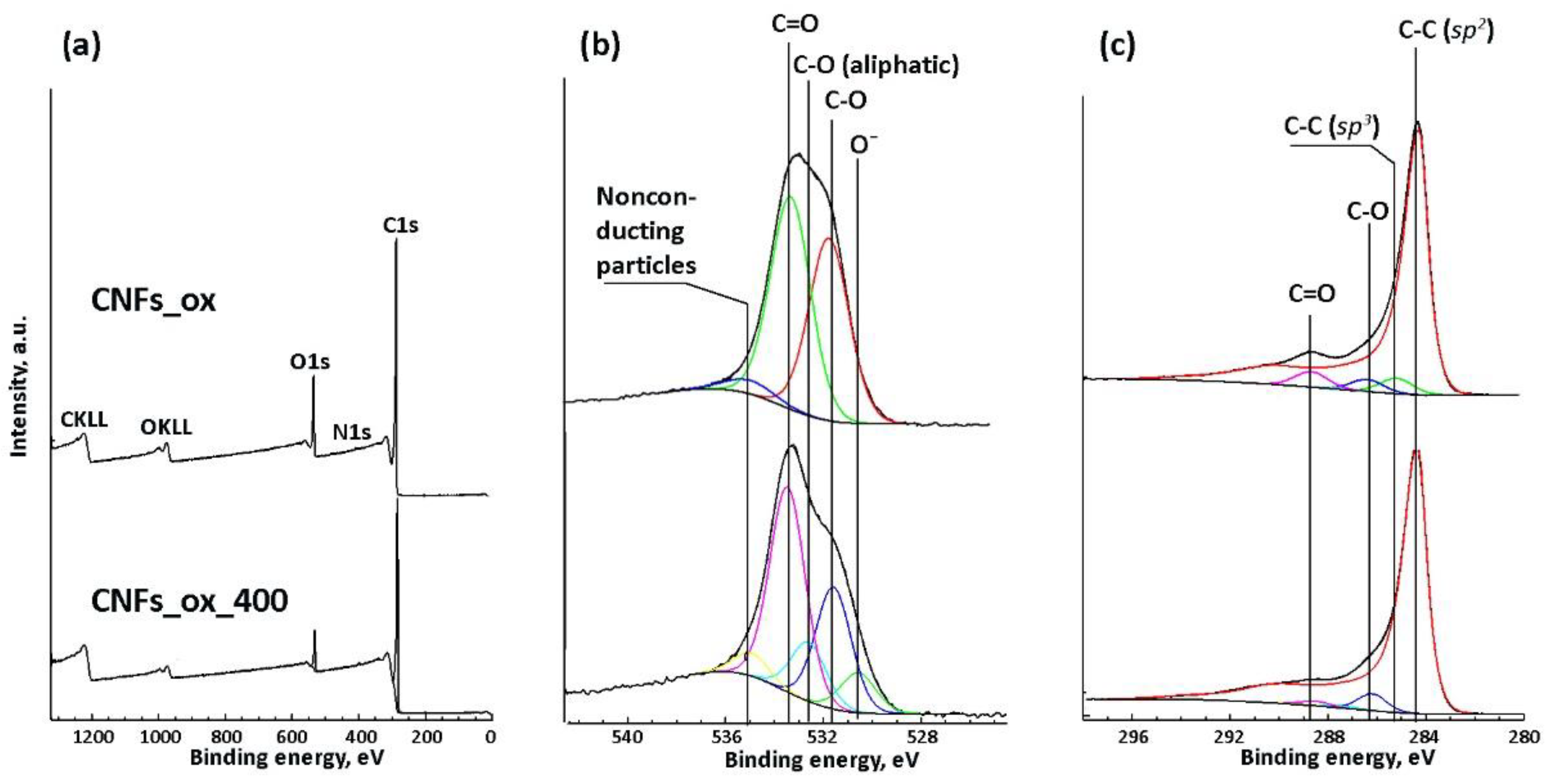
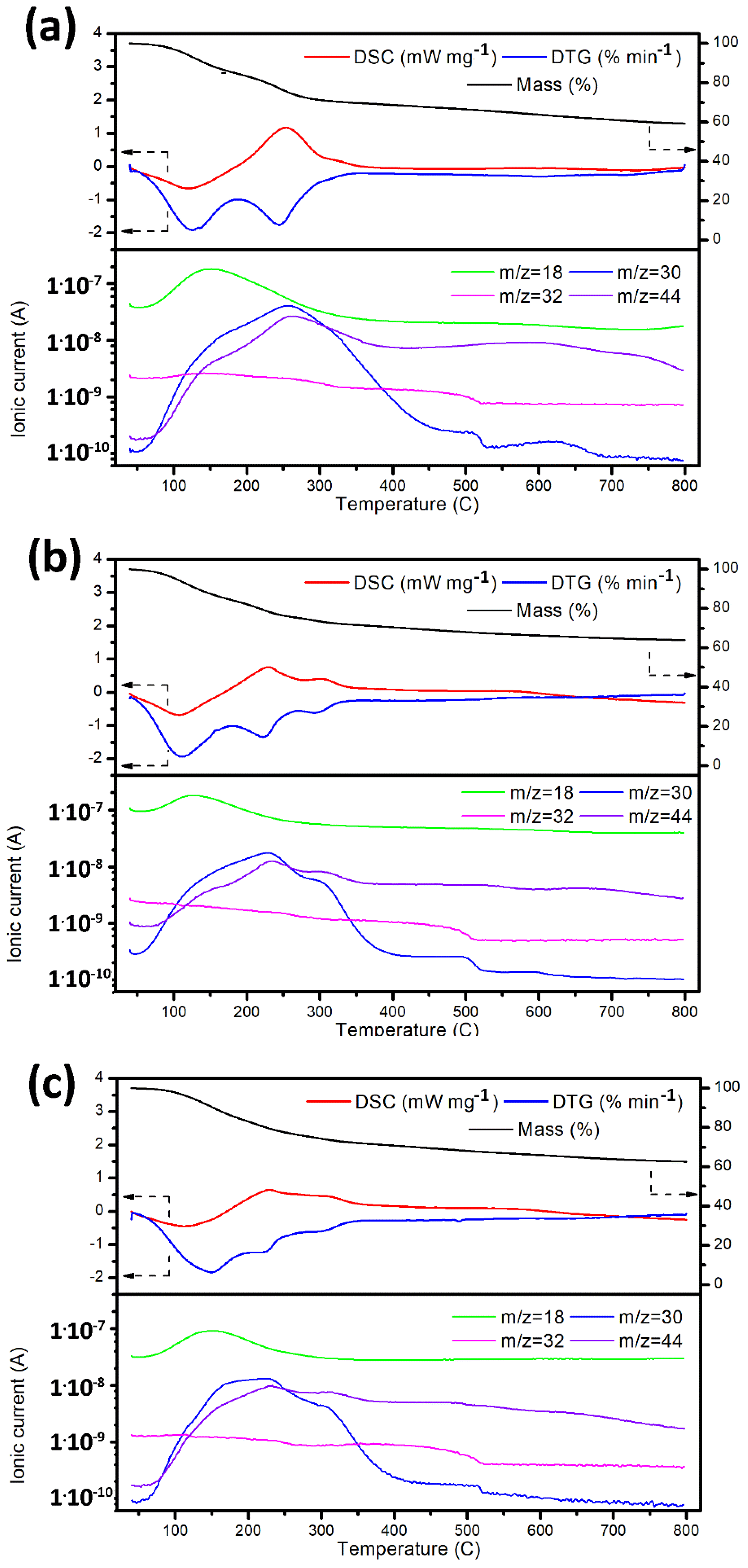
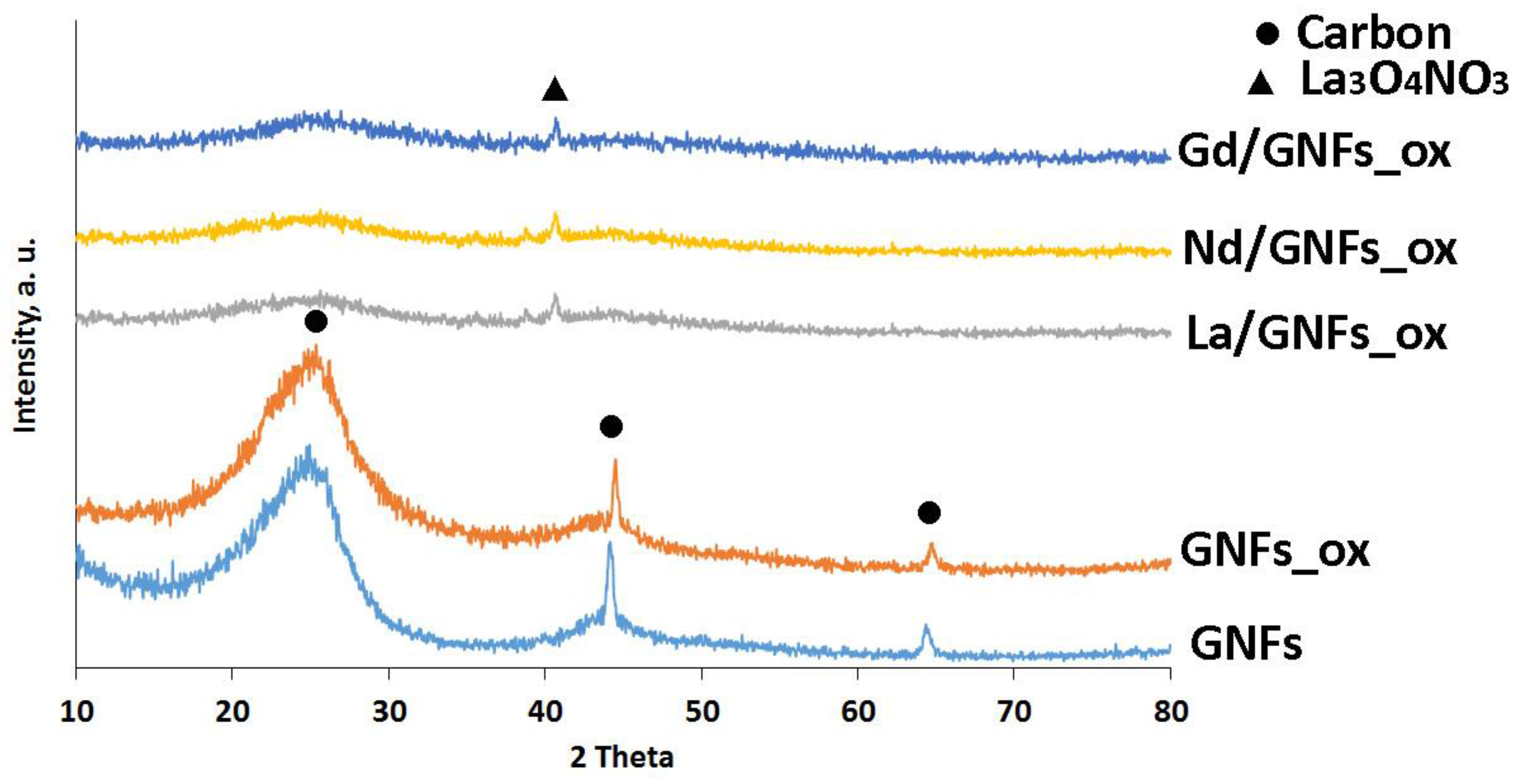
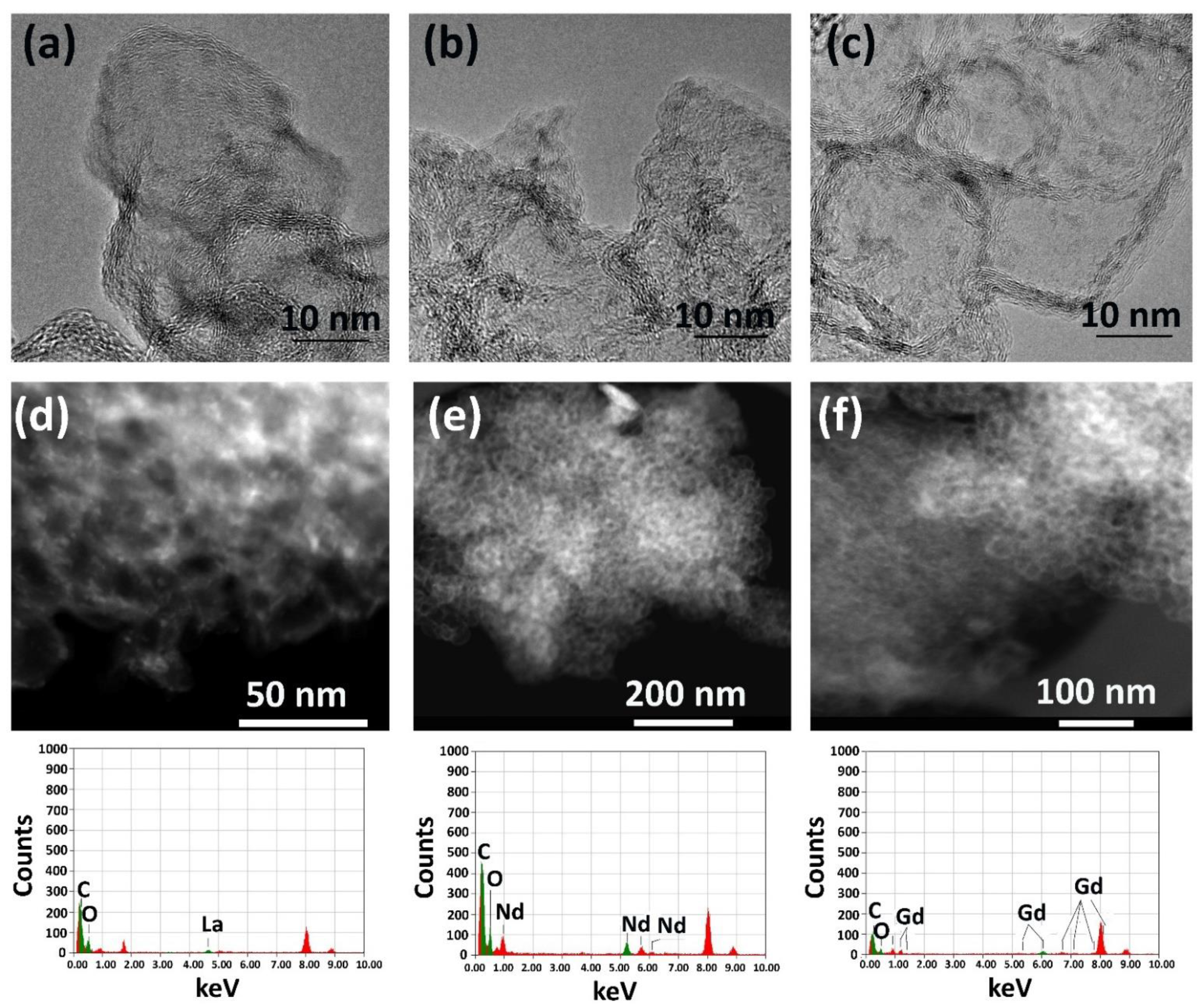
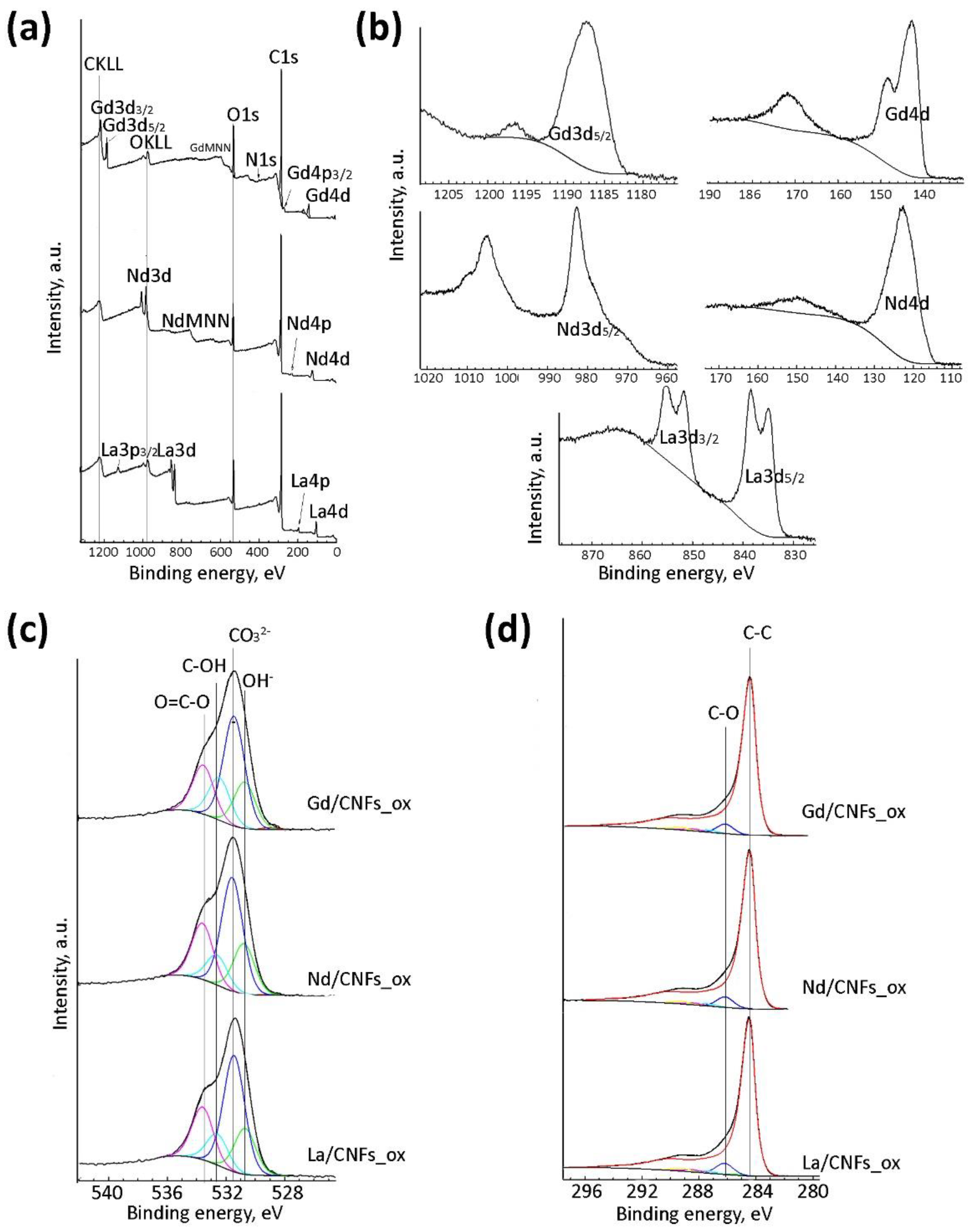

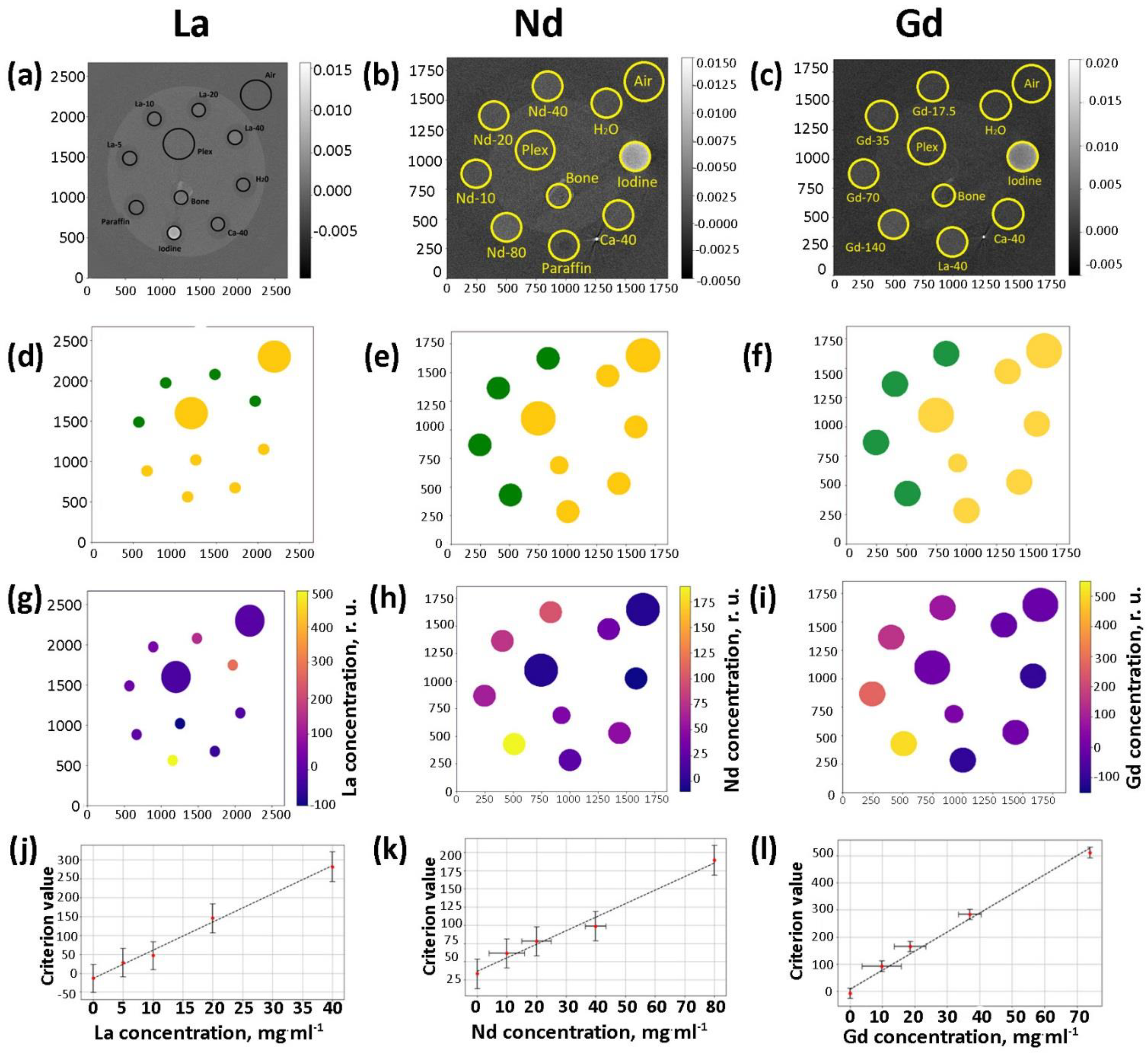
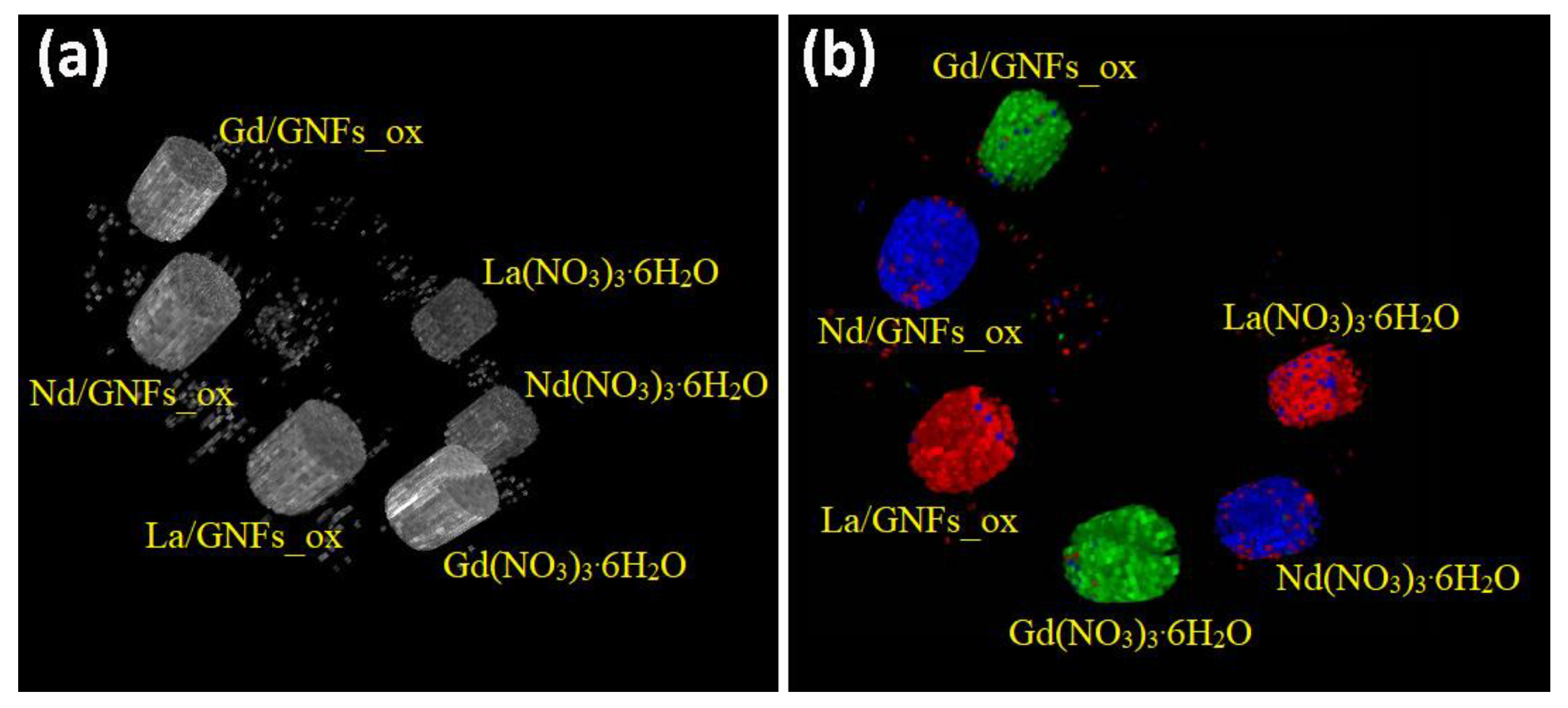
| Ln/GNFs_ox | Ln Content, wt. % | Weight Residue at 400 °C under Ar Atmosphere, wt. % | |
|---|---|---|---|
| Experimental | EDX | TG | |
| La | 9.3 | 12.9 | 68.7 |
| Nd | 9.6 | 9.7 | 70.4 |
| Gd | 10.8 | 11.6 | 70.8 |
Publisher’s Note: MDPI stays neutral with regard to jurisdictional claims in published maps and institutional affiliations. |
© 2022 by the authors. Licensee MDPI, Basel, Switzerland. This article is an open access article distributed under the terms and conditions of the Creative Commons Attribution (CC BY) license (https://creativecommons.org/licenses/by/4.0/).
Share and Cite
Suslova, E.V.; Kozlov, A.P.; Shashurin, D.A.; Rozhkov, V.A.; Sotenskii, R.V.; Maximov, S.V.; Savilov, S.V.; Medvedev, O.S.; Chelkov, G.A. New Composite Contrast Agents Based on Ln and Graphene Matrix for Multi-Energy Computed Tomography. Nanomaterials 2022, 12, 4110. https://doi.org/10.3390/nano12234110
Suslova EV, Kozlov AP, Shashurin DA, Rozhkov VA, Sotenskii RV, Maximov SV, Savilov SV, Medvedev OS, Chelkov GA. New Composite Contrast Agents Based on Ln and Graphene Matrix for Multi-Energy Computed Tomography. Nanomaterials. 2022; 12(23):4110. https://doi.org/10.3390/nano12234110
Chicago/Turabian StyleSuslova, Evgeniya V., Alexei P. Kozlov, Denis A. Shashurin, Vladislav A. Rozhkov, Rostislav V. Sotenskii, Sergei V. Maximov, Serguei V. Savilov, Oleg S. Medvedev, and Georgy A. Chelkov. 2022. "New Composite Contrast Agents Based on Ln and Graphene Matrix for Multi-Energy Computed Tomography" Nanomaterials 12, no. 23: 4110. https://doi.org/10.3390/nano12234110
APA StyleSuslova, E. V., Kozlov, A. P., Shashurin, D. A., Rozhkov, V. A., Sotenskii, R. V., Maximov, S. V., Savilov, S. V., Medvedev, O. S., & Chelkov, G. A. (2022). New Composite Contrast Agents Based on Ln and Graphene Matrix for Multi-Energy Computed Tomography. Nanomaterials, 12(23), 4110. https://doi.org/10.3390/nano12234110








